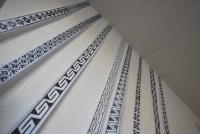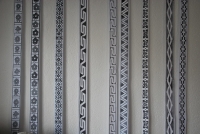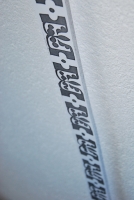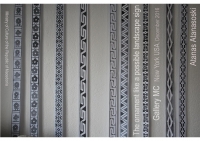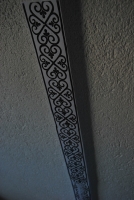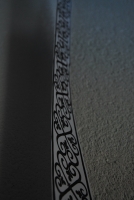Atanas Atanasoski: The Ornament Like a Possible Landscape Sign
THE ORNAMENT LIKE A POSSIBLE LANDSCAPE SIGN
(Орнаментот како можен пејсажен знак)
Reception for the Artist on Saturday, Dec. 3rd from 6 to 8 pm
ON THE ORNAMENTTS
The ornamentation as an autonomous phenomenon realized through a constant artistic materialization during a long historical and civilization process has found a wide application in different artistic disciplines. The same geometric motifs, interpreted in several variants, are manifested through different segments of the material culture: the stone plastic art, the ceramics, the ornamental illuminations in the church manuscripts, the fresco painting, the wood carving and the many objects made of metal or bones with an utilitarian function. Such objects are a suitable medium for pointing the basic ideas related to the creative potential of a culture. The ornamentation as part of the artistic cultural heritage is still reflecting the esthetic values incorporated in the design of many industrial products. Due to the common historical development and the style-technical parallels, the ornamental motifs have been directly included in the complex coding of the artistic engagements as the most powerful component of the visual culture.
The idea for this artistic project was a result of my long years of research of the ornamental motifs from the painting opus in the monuments of the fresco painting in Macedonia from the Byzantine and Post-Byzantine period. Using the available data and information I could acquire in the course of my research of the ornamentation, I tried to define more closely the idea and the concept, as well as the established chronological and typological classification of the forms and the analogies with the artistic influences.
The artistic opus of the Medieval and late Medieval period shows an abundant production which had been going on continually until the Rebirth period in the 19th century. The rich repertoire presented on the church walls from the Byzantine period is typical for the ambitious and complex topics, particular for the 13th and 14th centuries.
In the same period the wood carving was a significant activity in many monasteries in Macedonia. The preserved carved artworks point to an advanced creative activity with a high artistic level of wood carving. The wood carving center in the Prilep-Slepce region was active for a long period of time in the monasteries Treskavec, Zrze and Slepce. This wood carved works were typical for their shallow geometric relief with a high level of artistic rendering of the ornamental interlacement.
The time when the top wood carving achievements were made was also a period of considerable literary achievements. This is probably the reason for the high level of similarity between ornamentation in wood carving and the manuscripts of Slepce. The manuscript ornamentation was taken from the wood carving, only the motifs were magnified and copied as a shallow relief on a wooden basis. The manuscript heritage also speaks of a long cultural tradition in this region. The monastery of Slepce was important literary centre since the 12th century when a large number of richly ornamented literary works were made.
The ornament basically uses the line, the form and the rhythm as artistic expressive elements. The components composed of straight and broken lines and the developed sense of symmetry as well as the rhythmical multiplication provided the greatest visual game called ornamentation (pattern, decoration).
The rhythmical repetitions render a strongly emphasized dynamic which to a large extent depends on the arrangement of the motifs, the color, the form, the motion and the balance of the composition, while the rhythmical repetition of the motifs most complexly explains the essence of the ornament. Since the earliest times this phenomenon was given the status of philosophical category. It is equal to the principle by which the cosmic order functions: light-dark, soft-hard, hot-cold and the set thesis on the rhythmical repetition of life which moves to constant changes.
Atanas Atanasoski

